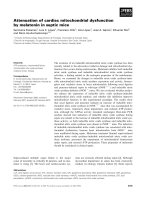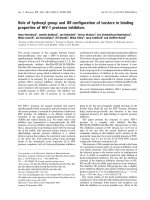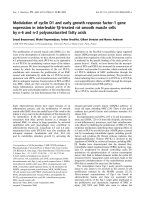Báo cáo khoa học: "Prevalence of Bartonella henselae and Bartonella clarridgeiae in cats and dogs in Korea" ppsx
Bạn đang xem bản rút gọn của tài liệu. Xem và tải ngay bản đầy đủ của tài liệu tại đây (366.88 KB, 3 trang )
JOURNAL OF
Veterinary
Science
Short Communication
J. Vet. Sci. (2009), 10(1), 85
87
DOI: 10.4142/jvs.2009.10.1.85
*Corresponding author
Tel: +82-2-880-1266; Fax: +82-2-880-1266
E-mail: ,
Prevalence of Bartonella henselae and Bartonella clarridgeiae in cats and
dogs in Korea
You-seok Kim
1
, Kyoung-won Seo
1
, Jong-hwa Lee
1
, Eun-wha Choi
3
, Hee-woo Lee
2
, Cheol-yong Hwang
1
,
Nam-shik Shin
2
, Hee-jeong Youn
2,
*
, Hwa Young Youn
1,
*
1
Department of Veterinary Internal Medicine and BK21 Program for Veterinary Science, and
2
KRF Priority Zoonotic Disease
Research Institute, College of Veterinary Medicine, Seoul National University, Seoul 151-742, Korea
3
Samsung Biomedical Research Institute, Samsung Medical Center, Seoul 135-710, Korea
Blood, saliva, and nail samples were collected from 54
dogs and 151 cats and analyzed for the presence of
Bartonella henselae with a novel nested polymerase chain
reaction (PCR) method. Bartonella (B.) henselae was
detected in feral cat blood (41.8%), saliva (44.1%), and
nail (42.7%) samples. B. henselae was also detected in pet
cat blood (33.3%), saliva (43.5%), and nail (29.5%)
samples and in pet dog blood (16.6%), saliva (18.5%), and
nail (29.6%) samples. Nine samples were infected with B.
clarridgeiae and 2 were co-infected with B. henselae and B.
clarridgeiae of blood samples of dogs. This report is the
first to investigate the prevalence of B. henselae and B.
clarridgeiae in dogs and cats in Korea, and suggests that
dogs and cats may serve as potential Bartonella reservoirs.
Keywords:
Bartonella, cats, cat-scratch disease, dogs, Korea
Introduction
The genus Bartonella (B.) includes at least 20 species and
subspecies, and several of these are human pathogens [22].
Clinical manifestations of Bartonella infection include
Carrion’s disease, trench fever, cat scratch disease, bacillary
angiomatosis, endocarditis, chronic bacteremia, neuroreti
nitis, and osteomyelitis [13]. Cat scratch disease is zoonotic
and primarily caused by B. henselae [15]. B. clarridgeiae
can also cause cat scratch fever. B. henselae and B.
clarridgeiae can also infect dogs [4,7], and both species
can function as bacterial reservoirs for infection [5,9,10,
18,19]. Cat scratch disease was recently reported in a
woman with a pet dog in Korea [5]. However, the prevalence
of Bartonella spp. from companion animals in Korea has
not been previously investigated. We examined the prevalence
of B. henselae and B. clarridgeiae in dogs and cats in the
present study using a recently developed nested PCR
method.
Blood, saliva, and nail samples were collected from
healthy pet dogs (n = 54) and cats (n = 48) at the Veterinary
Medical Teaching Hospital of Seoul National University,
Korea. All samples were collected from November 2005 to
July 2006. Feral cats (n = 103) were captured in
neighborhoods throughout Seoul and were isolated in an
animal shelter. B. henselae strain Houston-1 (ATCC 49882)
and B. clarridgeiae strain (ATCC 51734) were obtained
from the American Type Culture Collection (USA) and
used for positive control samples. Genomic DNA was
extracted using Genomic Blood DNA and Genomic Cell/
Tissue DNA Extraction Kits (iNtRoN Biotechnology,
Korea), per the manufacturer’s instructions. Primary PCR
was performed with the P-bhenfa (5’-TCTTCGTTTCTCT
TTCTTCA-3’) and P-benr1 (5’-CAAGCGCGCGCTCTA
ACC-3’) primers which amplified B. henselae (186 bp)
and B. clarridgeiae (168 bp) fragments. Nested PCR
amplified B. henselae (152 bp) and B. clarridgeiae (134
bp) fragments with the N-bhenf1a (5’-GATGATCCCAAG
CCTTCTGGC-3’) and N-bhenr (5’-AACCAACTGAGC
TACAAGCC-3’) primers [15]. Primary and nested PCR
reactions were performed as previously described [15].
All PCR products were analyzed by sequencing with an
automated sequencer ABI 3100 Genetic Analyzer (Bionics,
Korea) and results were confirmed to be from B. henselae
(GeneBank access number DQ000494) and from B.
clarridgeiae (GeneBank access number: DQ003029).
B. henselae was detected in 14.2% of blood samples
(14/98), 3.9% of saliva samples (4/102), and 4.8% of nail
samples (5/103) from feral cats. In contrast, only 6.3%
(3/48) of blood samples from pet cats were positive for B.
henselae. B.
henselae was not detected in pet cat saliva
samples (n = 46), pet cat nail samples (n = 44), or in any pet
86 You-seok Kim et al.
Samples
Number of positive samples / Number of tested samples (%)
Feral cats Pet cats Subtotal (Feral + Pet) Dogs
Blood
Saliva
Nails
41/98 (41.8)
45/102 (44.1)
44/103 (42.7)
16/48 (33.3)
20/46 (43.5)
13/44 (29.5)
57/146 (39.0)
65/148 (43.9)
57/147 (38.8)
9/54 (16.6)
10/54 (18.5)
16/54 (29.6)
Table 1 . Prevalence of Bartonella henselae infection in cat and dog blood, saliva, and nail samples detected by nested PCR
Samples
Number of positive samples / Number of tested samples (%)
Feral cats Pet cats Subtotal (Feral + Pet) Dogs
Blood
Saliva
Nails
2/98 (2.04)
2/102 (1.96)
0/103 (0.00)
0/48 (0.00)
0/46 (0.00)
0/44 (0.00)
2/146 (1.37)
2/148 (1.35)
0/147 (0.00)
3/54 (5.56)
1/54 (1.85)
1/54 (1.85)
Table 2 . Prevalence of Bartonella clarridgeiae infection in cat and dog blood, saliva, and nail samples detected by nested PCR
Fig. 1. Bartonella (B.) henselae (S2) and B. clarridgeiae (S1)
nested PCR amplification bands from 2 cats. The negative control
band (S3) is visualized on the right side. M: standard maker.
dog samples (n = 54).
B. henselae was detected in 41.8% (41/98) of blood
samples, 44.1% (45/102) of saliva samples, and 42.7%
(44/103) of nail samples from feral cats by nested PCR. In
addition, 33.3% of blood samples (16/48), 43.5% of saliva
samples (20/46), and 29.5% of nail samples (13/44) from
pet cats were B. henselae positive. B. henselae DNA was
also detected in 16.6% (9/54) blood samples, 18.5%
(10/54) of saliva samples and 29.6% (16/54) of nail
samples from dogs (Table 1).
B. clarridgeiae was detected in 2 feral cat blood samples,
a feral cat saliva sample, 3 dog blood samples, a dog saliva
sample, and 2 dog nail samples. Additionally, 2 samples (1
dog blood and 1 dog nail) were co-infected with B.
henselae and B. clarridgeiae (Table 2). PCR product and
DNA sequencing data are shown in Fig. 1.
Cats are usually the main zoonotic reservoir for Bartonella
infection [14], although dogs may also serve as zoonotic
reservoirs secondary to B. henselae and B. clarridgeiae
infection [4,7]. Cat scratch disease was identified in a case
with suspected human:canine transmission in Korea
[5,18]. However, there are no current surveys evaluating
Bartonella spp. prevalence in cats and dogs.
A previous study reported that 39% of cats were B.
henselae positive among a population of 146 cats in Japan
[11], and this result was significantly higher than the
previous 7.2% prevalence among cats in Japan. Previous
studies conducted in various countries identified higher
Bartonella bacteremia prevalence in shelter cats than in pet
cats [2,3,8,10]. The Bartonella prevalence in pet cats in the
present study (33.3%) was significantly higher than the
prevalence in previous studies, including Germany (13%),
France (11%), and the Netherlands (22%) [1,5,17].
Conversely, the prevalence of B. henselae in sheltered cats
(41.8%) was similar to the prevalence identified in other
studies. These findings suggest that pet cats may serve as a
reservoir for B. henselae infection to their owners. This is
particularly relevant to immunocompromised pet owners.
B. henselae prevalence in cats is higher than B. clarridgeiae
prevalence [16], but this may be dependent on age, sex, and
type of breeding [6]. The B. henselae prevalence in cats and
dogs was greater than B. clarridgeiae and was higher in cats
than in dogs. These results supported previous studies which
suggested that B. henselae was the major zoonotic pathogen.
A recent survey of Bartonella seropositive healthy blood
donor in Sweden demonstrated a similar prevalence to
Prevalence of Bartonella henselae and Bartonella clarridgeiae in cats and dogs in Korea 87
dogs in the present study [12]. Zoonotic diseases have
become an increasingly important public health concern
[5]. Our results suggest that B. henselae and B. clarridgeiae
are highly prevalent in Korean cats and dogs. Further, cats
and dogs may serve as reservoirs for human Bartonella
infection.
In conclusion, data from the present study suggests that
Bartonella infection prevalence in Korean shelter cats is
similar to those of previously described countries. However,
the prevalence of B. henselae in Korean pet cats was higher
than reported prevalence in other countries. This is the first
report examining the prevalence of B. henselae and B.
clarridgeiae infection in domestic cats and dogs in Korea.
Acknowledgments
This work was supported by Korean Research Foundation
Grant (KRF-2006-005-J02902). Further supports were also
provided by the Research Institute of Veterinary Science,
and the BK21 Program for Veterinary Science, College of
Veterinary Medicine, Seoul National University.
References
1. Bergmans AM, de Jong CM, van Amerongen G, Schot
CS, Schouls LM. Prevalence of Bartonella species in
domestic cats in The Netherlands. J Clin Microbiol 1997, 35,
2256-2261.
2. Branley J, Wolfson C, Waters P, Gottlieb T, Bradbury R.
Prevalence of Bartonella henselae bacteremia, the causative
agent of cat scratch disease, in an Australian cat population.
Pathology 1996, 28, 262-265.
3. Chomel BB, Carlos ET, Kasten RW, Yamamoto K, Chang
CC, Carlos RS, Abenes MV, Pajares CM. Bartonella
henselae and Bartonella clarridgeiae infection in domestic
cats from The Philippines. Am J Trop Med Hyg 1999, 60,
593-597.
4. Chomel BB, Mac Donald KA, Kasten RW, Chang CC,
Wey AC, Foley JE, Thomas WP, Kittleson MD. Aortic
valve endocarditis in a dog due to Bartonella clarridgeiae. J
Clin Microbiol 2001, 39, 3548-3554.
5. Chung JY, Han TH, Kim BN, Yoo YS, Lim SJ. Detection
of Bartonella henselae DNA by polymerase chain reaction
in a patient with cat scratch disease: a case report. J Korean
Med Sci 2005, 20, 888-891.
6. Engvall EO, Br
ändström B, Fermér C, Blomqvist G,
Englund L. Prevalence of Bartonella henselae in young,
healthy cats in Sweden. Vet Rec 2003, 152, 366-369.
7. Gundi VA, Bourry O, Davous B, Raoult D, La Scola B.
Bartonella clarridgeiae and B. henselae in dogs, Gabon.
Emerg Infect Dis 2004, 10, 2261-2262.
8. Heller R, Artois M, Xemar V, De Briel D, Gehin H, Jaulhac
B, Monteil H, Piemont Y. Prevalence of Bartonella henselae
and Bartonella clarridgeiae in stray cats. J Clin Microbiol
1997, 35, 1327-1331.
9. Keret D, Giladi M, Kletter Y, Wientroub S. Cat-scratch
disease osteomyelitis from a dog scratch. J Bone Joint Surg
Br 1998, 80, 766-767.
10. Marston EL, Finkel B, Regnery RL, Winoto IL, Graham
RR, Wignal S, Simanjuntak G, Olson JG. Prevalence of
Bartonella henselae and Bartonella clarridgeiae in an urban
Indonesian cat population. Clin Diagn Lab Immunol 1999, 6,
41-44.
11. Maruyama S, Nakamura Y, Kabeya H, Tanaka S, Sakai
T, Katsube Y. Prevalence of Bartonella henselae, Bartonella
clarridgeiae and the 16S rRNA gene types of Bartonella
henselae among pet cats in Japan. J Vet Med Sci 2000, 62,
273-279.
12. McGill S, Wessl
én L, Hjelm E, Holmberg M, Auvinen
MK, Berggren K, Grandin-Jarl B, Johnson U, Wikstr
öm
S, Friman G. Bartonella spp. seroprevalence in healthy
Swedish blood donors. Scand J Infect Dis 2005, 37, 723-730.
13. Molia S, Chomel BB, Kasten RW, Leutenegger CM,
Steele BR, Marker L, Martenson JS, Keet DF, Bengis
RG, Peterson RP, Munson L, O'Brien SJ. Prevalence of
Bartonella infection in wild African lions (Panthera leo) and
cheetahs (Acinonyx jubatus). Vet Microbiol 2004, 100,
31-41.
14. Pons I, Sanfeliu I, Quesada M, Anton E, Sampere M,
Font B, Pla J, Segura F. Prevalence of Bartonella henselae
in cats in Catalonia, Spain. Am J Trop Med Hyg 2005, 72,
453-457.
15. Rampersad JN, Watkins JD, Samlal MS, Deonanan R,
Ramsubeik S, Ammons DR. A nested-PCR with an Internal
Amplification Control for the detection and differentiation
of Bartonella henselae and B. clarridgeiae: an examination
of cats in Trinidad. BMC Infect Dis 2005, 5, 63.
16. Rolain JM, Locatelli C, Chabanne L, Davoust B, Raoult
D. Prevalence of Bartonella clarridgeiae and Bartonella
henselae in domestic cats from France and detection of the
organisms in erythrocytes by immunofluorescence. Clin
Diagn Lab Immunol 2004, 11, 423-425.
17. Sander A, B
ühler C, Pelz K, von Cramm E, Bredt W.
Detection and identification of two Bartonella henselae
variants in domestic cats in Germany. J Clin Microbiol 1997,
35, 584-587.
18. Tsukahara M, Tsuneoka H, Iino H, Ohno K, Murano I.
Bartonella henselae infection from a dog. Lancet 1998, 352,
1682.
19. Windsor JJ. Cat-scratch disease: epidemiology, aetiology
and treatment. Br J Biomed Sci 2001, 58, 101-110.
20. Yamamoto K, Chomel BB, Kasten RW, Hew CM, Weber
DK, Lee WI, Koehler JE, Pedersen NC. Infection and
re-infection of domestic cats with various Bartonella species
or types: B. henselae type I is protective against heterologous
challenge with B. henselae type II. Vet Microbiol 2003, 92,
73-86.









